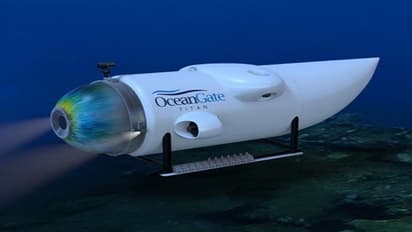Missing Titanic submersible: 'Underwater noises' detected by rescuers

Synopsis
Canadian aircraft have detected “underwater noises in the search area” for the missing Titan submersible, the US Coast Guard said early on Wednesday, amid US media reports that regular “banging sounds” have been picked up.
The US Coast Guard said Wednesday that rescuers using sonar to look for the missing Titanic submersible with five people on board heard "underwater noises" in the North Atlantic close to where the ship went missing two days earlier. "Canadian P-3 aircraft heard sounds under the surface while searching. As a result, ROV (remotely operated vehicle) activities were moved in an effort to investigate the source of the noises," according to a tweet from the US Coast Guard's First District.
The ROV searches "have yielded negative results but continue," the military unit stated, adding that information from the Canadian aircraft had been sent to US Navy specialists so that they could use it to guide further search strategies.
The announcement is the most encouraging sign yet that the tourists who were en route Sunday to visit the wreckage of the Titanic in a 21-foot (6.5-meter) minisub might still be alive, as rescue teams race to reach them before their air supply runs out.
US and Canadian coast guard ships and planes are scouring 7,600 square miles of ocean -- larger than the US state of Connecticut -- for the vessel, which was attempting to dive some 400 miles off the coast of Newfoundland, Canada.
The submersible, named Titan, was carrying three fee-paying passengers: British billionaire Hamish Harding, Pakistani businessman Shahzada Dawood, and his son Suleman. Stockton Rush, the CEO of OceanGate Expeditions, and Paul-Henri Nargeolet, a French submarine operator, were also there.
The missing vessel, which is being searched for by the Canadian and Boston coast guards, belongs to the tour operator OceanGate Expeditions and the cost per ticket for the Titanic wreckage expedition is said to be $250,000. It boasts a 4K Rayfin camera from Sub C Imaging, 2D sonar from Teledyne, 40,000 lumens of external illumination, and a laser scanner from 2G Robotics
Check the Breaking News Today and Latest News from across India and around the world. Stay updated with the latest World News and global developments from politics to economy and current affairs. Get in-depth coverage of China News, Europe News, Pakistan News, and South Asia News, along with top headlines from the UK and US. Follow expert analysis, international trends, and breaking updates from around the globe. Download the Asianet News Official App from the Android Play Store and iPhone App Store for accurate and timely news updates anytime, anywhere.